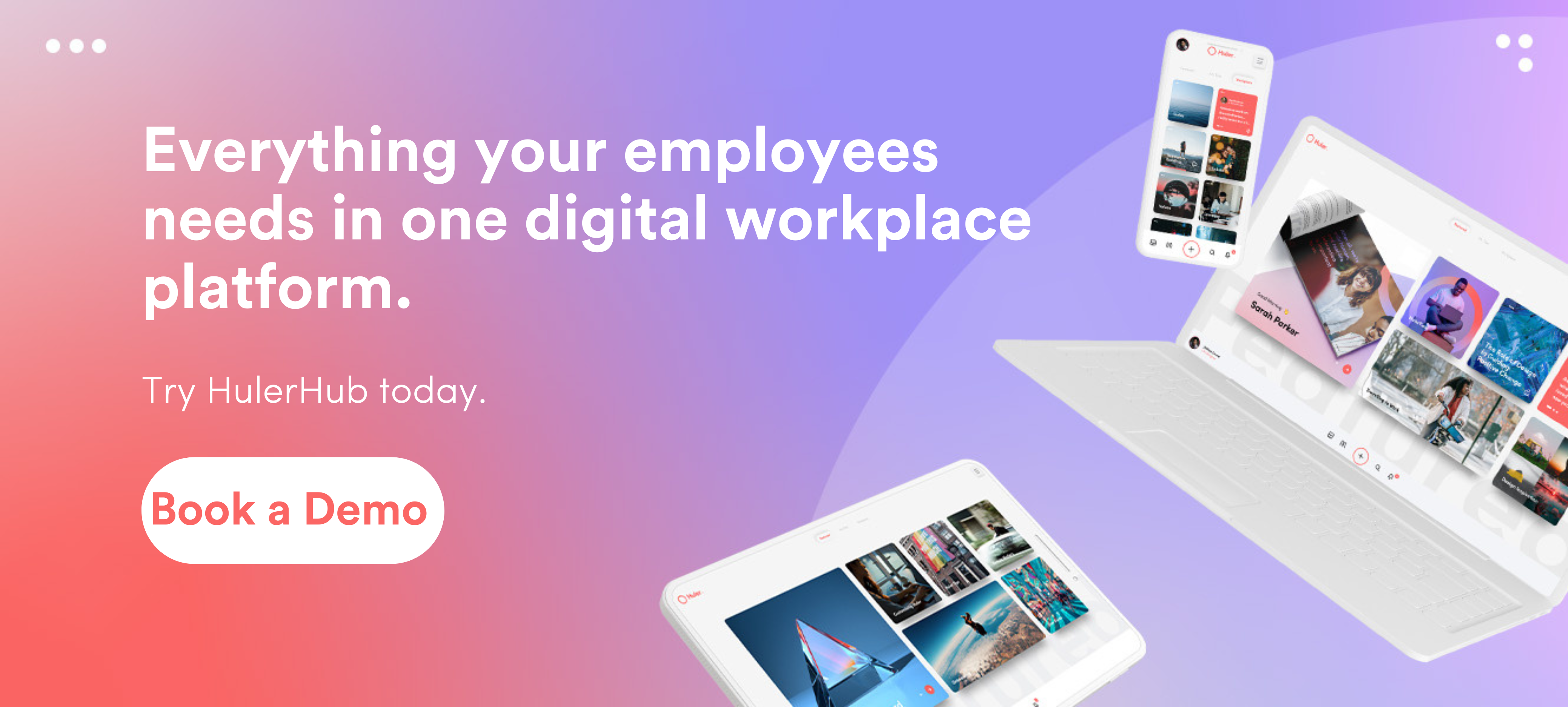The digital workplace is becoming commonplace. With companies becoming more agile, and people working across different countries and time zones, digital workplaces are helping to keep companies united. But it’s not good enough to throw together a digital workplace comprised of scattered tools, hosted in an old-school intranet. Digital workplace transformation is changing that.
Digital workplace transformation is all about making sure that the right technology is being used in the right way, to create a work environment that supports employees and improves productivity. When 83% of employees rely on technology for collaboration, you can see how important the right digital workplace transformation is.
Read on to find out more about what it means, why it’s important, and why now’s the time to transform your digital workplace…
Suggested Reading: For more information on the digital workplace, read our explainer — What is a Digital Workplace?
What Is Digital Transformation?
Digital workplace transformation is the incorporation of new technologies into a business to improve how that business works. It’s not a destination, but a journey, where organisations identify areas where technology and digital strategies can streamline work processes. And at the same time, it improves the customer and digital employee experience.
What’s important to understand about digital workplace transformation is that it looks different for every business. The uniting factor about this process is that it starts by thinking outside of the box. In a technology-driven world, leaders must realise that it is not always possible, or effective, to carry old business practices over into new ones. Instead, a growth mindset is required along with an open-minded approach to emerging technologies and their potential applications to business.
Digital workplace transformation also targets a problem or a goal. It’s not ‘tech for the sake of tech’. Effective digital transformation is about using tech in response to an ongoing issue or sticking point. For example, organisations might identify improvements that could be made to their customer or employee experience and explore how different technologies could achieve the desired goal.
Why is digital transformation in the workplace important?
Digital workplace transformation is important because it can:
- Give your business a competitive edge
- Help your organisation to be more agile and resilient
- Bring together information and resources to be better used across the business
- Help businesses collect the right data and use it in the right ways
- Improve the customer experience
- Increase employee engagement
- Encourage more collaboration and innovation from anywhere
- Boost productivity
When the Covid-19 pandemic reared its head, digital workplace transformation became a sink or swim matter. Any organisation that buried its head in the sand quickly found itself falling behind the competition.
But businesses that opened their minds to technology were invariably the ‘winners’ of the pandemic. And arguably, will also be the ones who continue to forge ahead in the future as long as they are armed with the same flexible growth mindset and willingness to try new things.
And that is why digital transformation is so important for businesses: the world will not wait for you to catch up. Digital technology is setting the benchmark for what customers and employees expect, and if your business is unable to provide the same experience in all areas both will vote with their feet.
Digital workplace transformation is crucial to the evolution of any business. It’s become clear that the early adopters — those businesses who are open to trying new things and not necessarily afraid of ‘failure’ — are ultimately the ones that pull ahead in the long run.
Examples of digital workplace transformation
So, what does it actually look like? Digital workplace transformation can look different across different businesses and sectors. Here are just a few examples to give you an inside look at what to expect.
Recruitment
The aim of digital workplace transformation in recruitment is to simplify or eliminate admin tasks while increasing operational efficiency through the integration of tech solutions.
This includes video conferencing technologies, which simplify the face-to-face interview process and also allow for more flexibility in how, when and where a candidate is interviewed. Other technologies such as applicant tracking software, pre-employment assessments, and AI chatbots are also being put to good use throughout the recruitment journey from candidate sourcing right down to the final hiring decision.
And by curating content into one place through collections, you help the candidate access the information they need. This can include information about the company, the hiring panel, and the interviewing and hiring process.
Learning & Development
Upskilling employees is now more important than ever for businesses. As organisations recognise how beneficial it is to grow skills internally, all eyes are on learning and development from here on out.
Transformation in learning and development is much needed as we come to terms with the fact that learning doesn’t just happen in a classroom. It can happen anywhere, including on the job and in virtual environments.
A great example of digital transformation in learning and development is the advent of learning experience platforms. While learning management systems have been common in the workplace for quite a while now, learning experience platforms are making use of technologies like artificial intelligence, machine learning, gamification and virtual reality (to name a few) in order to deliver more personalised learning experiences for employees.
Technologies are also being used to make learning and development in the workplace more hands-on and interactive. Virtual reality, for example, is a powerful way for employees to safely and realistically put new skills into practice and apply them to the flow of work.
Transforming employee experience
Positive digital employee experiences make a big difference to productivity, collaboration, innovation, creativity and growth. So it makes sense that businesses would be turning to digital transformation to create more positive employee experiences across the board.
Employee experience platforms are just one way HR and people teams are taking control of this. These clever cloud-based systems work to streamline and automate parts of the employee experience, allowing leaders to take a people-first culture that isn’t bogged down in paperwork and admin. What’s more, employee experience platforms also provide personalisation throughout crucial touchpoints in the employee journey to better help organisations take control of, and redefine, elements of it.
Other technologies being used to redefine the employee experience include employee engagement platforms, onboarding tools, productivity tools, learning platforms, wellbeing initiatives and much more.
Drivers of digital workplace transformation
Outdated processes
One of the main drivers of digital transformation is the identification of slow, outdated processes and legacy technologies. Very rarely does digital transformation come about because of new technology specifically, rather a problem emerges first which can be overcome with the help of a technological solution.
The Domino Effect
As more and more businesses move to the cloud, it’s likely that more opportunities for digital transformation will arise to make the transformation smoother and more effective. This will be exacerbated further by the rise in remote and hybrid working, as access from anywhere on any device becomes essential, rather than just a nice to have.
Security issues
Privacy and security are hot topics right now. From customer to employee data, the introduction of new legislation such as GDPR in the UK means that organisations need to get even more serious about how they manage and store information. On top of this, the rise in remote and hybrid working also brings with it a number of security issues.
During the pandemic, there was a huge spike in cybercrime and fraud, partly due to the fact that employees were working from home, on unsecured networks, and sometimes from their own devices. From this knowledge alone, it is clear why digital transformation is needed to ensure employees and data remain safe and secure as the work from anywhere revolution continues to gain traction.
Customer demand
Your customers are used to slick user experiences. If a business can’t provide that, it’s fair to say it probably won’t enjoy the same growth as one that embraces digital transformation.
This doesn’t just refer to paying customers either, it also refers to ‘internal customers’, AKA your employees. We all use technology in our day-to-day life, and most of it fits seamlessly into our lives from our mobile phones to the virtual assistants in our homes. That being said, it’s fair to say that up until recently there has been an incongruence between our personal tech and work tech.
For example, intranets or customer portals can be very outdated, slow and unintuitive. This results in low employee engagement or low customer engagement – both of which no one wants to see. Digital workplace transformation presents an opportunity to level up your technology offerings in line with what your customers, both external and internal, are used to in order to get better engagement from the people that matter most to your business.
Kickstart your digital transformation strategy
Digital workplace transformation can revolutionise your business — when done right.
Here at Huler, we are passionate about helping organisations level up their work tech game with the help of HulerHub, our revolutionary digital workplace and employee engagement platform. To find out more about HulerHub, book a demo now to speak to a member of our team.
FAQs
What is a digital workplace?
A digital workplace is a secure cloud-based platform that helps businesses empower and enable their workforce to be productive whether they work remotely, on-site or a mix between the two. These platforms are securely accessible from any device, at any time, anywhere in the world and contain everything employees need to do their jobs effectively such as applications, data, content, files, tools, software and documents.
What is digital workplace transformation?
Digital workplace transformation is the incorporation of new technologies into a business to improve how that business works. It’s an ongoing process to make sure the right workplace technologies are used in the right way, to improve customer and employee experience.
Why is digital workplace transformation important?
Digital workplace transformation is important because it makes sure your business is connected across wherever employees work, that customers get the best experience possible and employees are engaged with their work. In a working environment when remote and hybrid working is becoming the norm, making sure all employees are connected by technology is crucial.








